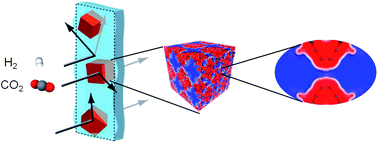Feasibility of zeolitic imidazolate framework membranes for clean energy applications†
Abstract
Gas separation technologies for carbon-free hydrogen and clean gaseous

Maintenance work is planned for Wednesday 1st May 2024 from 9:00am to 11:00am (BST).
During this time, the performance of our website may be affected - searches may run slowly and some pages may be temporarily unavailable. If this happens, please try refreshing your web browser or try waiting two to three minutes before trying again.
We apologise for any inconvenience this might cause and thank you for your patience.
* Corresponding authors
a
CSIRO Materials Science and Engineering, Process Science and Engineering, Private Bag 33, Clayton Sth MDC, Victoria, Australia
E-mail:
aaron.thornton@csiro.au
Fax: +61 03 9545 2837
Tel: +61 03 9545 8018
b Van't Hoff Institute for Molecular Sciences, University of Amsterdam, 904 Science Park, XH, Netherlands
c CSIRO Mathematics, Informatics and Statistics, Private Bag 33, Clayton Sth MDC, Victoria, Australia
d Department of Chemical Engineering, Monash University, Clayton, Victoria, Australia
e School of Chemistry, University of Melbourne, Parkville, Victoria, Australia
Gas separation technologies for carbon-free hydrogen and clean gaseous

 Please wait while we load your content...
Something went wrong. Try again?
Please wait while we load your content...
Something went wrong. Try again?
A. W. Thornton, D. Dubbeldam, M. S. Liu, B. P. Ladewig, A. J. Hill and M. R. Hill, Energy Environ. Sci., 2012, 5, 7637 DOI: 10.1039/C2EE21743K
To request permission to reproduce material from this article, please go to the Copyright Clearance Center request page.
If you are an author contributing to an RSC publication, you do not need to request permission provided correct acknowledgement is given.
If you are the author of this article, you do not need to request permission to reproduce figures and diagrams provided correct acknowledgement is given. If you want to reproduce the whole article in a third-party publication (excluding your thesis/dissertation for which permission is not required) please go to the Copyright Clearance Center request page.
Read more about how to correctly acknowledge RSC content.
 Fetching data from CrossRef.
Fetching data from CrossRef.
This may take some time to load.
Loading related content
